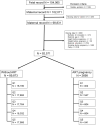Preconception vitamin D intake and obstetric outcomes in women using assisted reproductive technology: the Japan Environment and Children's Study
- PMID: 35790896
- PMCID: PMC9254408
- DOI: 10.1186/s12884-022-04861-2
Preconception vitamin D intake and obstetric outcomes in women using assisted reproductive technology: the Japan Environment and Children's Study
Abstract
Background: In reproductive medicine, vitamin D (VitD) is of particular interest because its deficiency has been linked to various infertility issues. Thus, preconception care, including appropriate VitD supplementation, is essential, especially in women using assisted reproductive technology (ART). Despite the therapeutic benefits of VitD, adverse events due to a high daily intake may influence obstetric outcomes. However, the effects of either low or high preconception VitD intake on obstetric outcomes, including the outcomes in women who used ART, remain unclear. Therefore, the aim of this study was to examine the association between pre-pregnancy daily VitD intake and obstetric outcomes in Japanese women, including those who conceived through ART.
Methods: Data were obtained from the Japan Environment and Children's study database comprising 92,571 women recruited between January 2011 and March 2014 in Japan. Participants were categorized into five quintiles according to pre-pregnancy VitD intake (Q1 and Q5 had the lowest and highest VitD intake, respectively) and stratified according to the use of ART. Multiple logistic regression was performed to identify the effects of pre-pregnancy VitD intake on preterm birth (PTB), low-birth weight infant (LBW), and small for gestational age (SGA).
Results: Using Q3 (middle VitD intake) as a reference, our analysis revealed that Q5 (highest VitD intake) showed an increased risk of LBW < 1500 g (adjusted odds ratio [aOR]: 1.09, 95% confidence interval [CI]: 1.00-1.18) and SGA (aOR: 1.26, 95% CI: 1.14-1.39) among women who conceived without ART. Among women who conceived with ART, we found that Q5 (highest VitD intake) showed an increased risk of PTB at < 37 weeks (aOR: 2.05, 95% CI: 1.27-3.31).
Conclusion: The present study revealed that higher VitD intake before pregnancy may affect perinatal outcomes, particularly in women using ART. Our findings may facilitate personalized preconceptional counseling regarding VitD intake based on the method of conception, especially among women using ART.
Keywords: Gestational age; Preconception care; Pregnancy; Premature birth; Vitamin D.
© 2022. The Author(s).
Conflict of interest statement
The authors declare that they have no competing interests.
Figures
Similar articles
-
Association between Preconception Dietary Fiber Intake and Preterm Birth: The Japan Environment and Children's Study.Nutrients. 2024 Feb 29;16(5):713. doi: 10.3390/nu16050713. Nutrients. 2024. PMID: 38474840 Free PMC article.
-
Influence of preconception carbohydrate intake on hypertensive disorders of pregnancy: The Japan Environment and Children's Study.J Obstet Gynaecol Res. 2023 Feb;49(2):577-586. doi: 10.1111/jog.15501. Epub 2022 Nov 21. J Obstet Gynaecol Res. 2023. PMID: 36411062
-
Association between preconception dietary fiber intake and hypertensive disorders of pregnancy: The Japan Environment and Children's Study.Pregnancy Hypertens. 2024 Sep;37:101139. doi: 10.1016/j.preghy.2024.101139. Epub 2024 Jun 14. Pregnancy Hypertens. 2024. PMID: 38878601
-
Why do singletons conceived after assisted reproduction technology have adverse perinatal outcome? Systematic review and meta-analysis.Hum Reprod Update. 2013 Mar-Apr;19(2):87-104. doi: 10.1093/humupd/dms044. Epub 2012 Nov 14. Hum Reprod Update. 2013. PMID: 23154145 Review.
-
The health of children conceived by ART: 'the chicken or the egg?'.Hum Reprod Update. 2019 Mar 1;25(2):137-158. doi: 10.1093/humupd/dmz001. Hum Reprod Update. 2019. PMID: 30753453 Review.
Cited by
-
Association between Gestational Weight Gain and Risk of Hypertensive Disorders of Pregnancy among Women with Obesity: A Multicenter Retrospective Cohort Study in Japan.Nutrients. 2023 May 23;15(11):2428. doi: 10.3390/nu15112428. Nutrients. 2023. PMID: 37299392 Free PMC article.
-
Prenatal Vitamin D Deficiency and Maternal and Fetal Health Outcomes.Cureus. 2024 Sep 16;16(9):e69508. doi: 10.7759/cureus.69508. eCollection 2024 Sep. Cureus. 2024. PMID: 39416583 Free PMC article. Review.
-
Predicting postpartum hemorrhage in women undergoing planned cesarean section: A multicenter retrospective cohort study in Japan.PLoS One. 2024 Jul 9;19(7):e0306488. doi: 10.1371/journal.pone.0306488. eCollection 2024. PLoS One. 2024. PMID: 38980883 Free PMC article.
References
-
- Petrelli F, Luciani A, Perego G, Dognini G, Colombelli PL, Ghidini A. Therapeutic and prognostic role of vitamin D for COVID-19 infection: a systematic review and meta-analysis of 43 observational studies. J Steroid Biochem Mol Biol. 2021;211:105883. doi: 10.1016/j.jsbmb.2021.105883. - DOI - PMC - PubMed
-
- Iliuta F, Pijoan JI, Lainz L, Exposito A, Matorras R. Women’s vitamin D levels and IVF results: a systematic review of the literature and meta-analysis, considering three categories of vitamin status (replete, insufficient and deficient) Hum Fertil (Camb) 2020;14:1–19. doi: 10.1080/14647273.2020.1807618. - DOI - PubMed
MeSH terms
Substances
LinkOut - more resources
Full Text Sources


